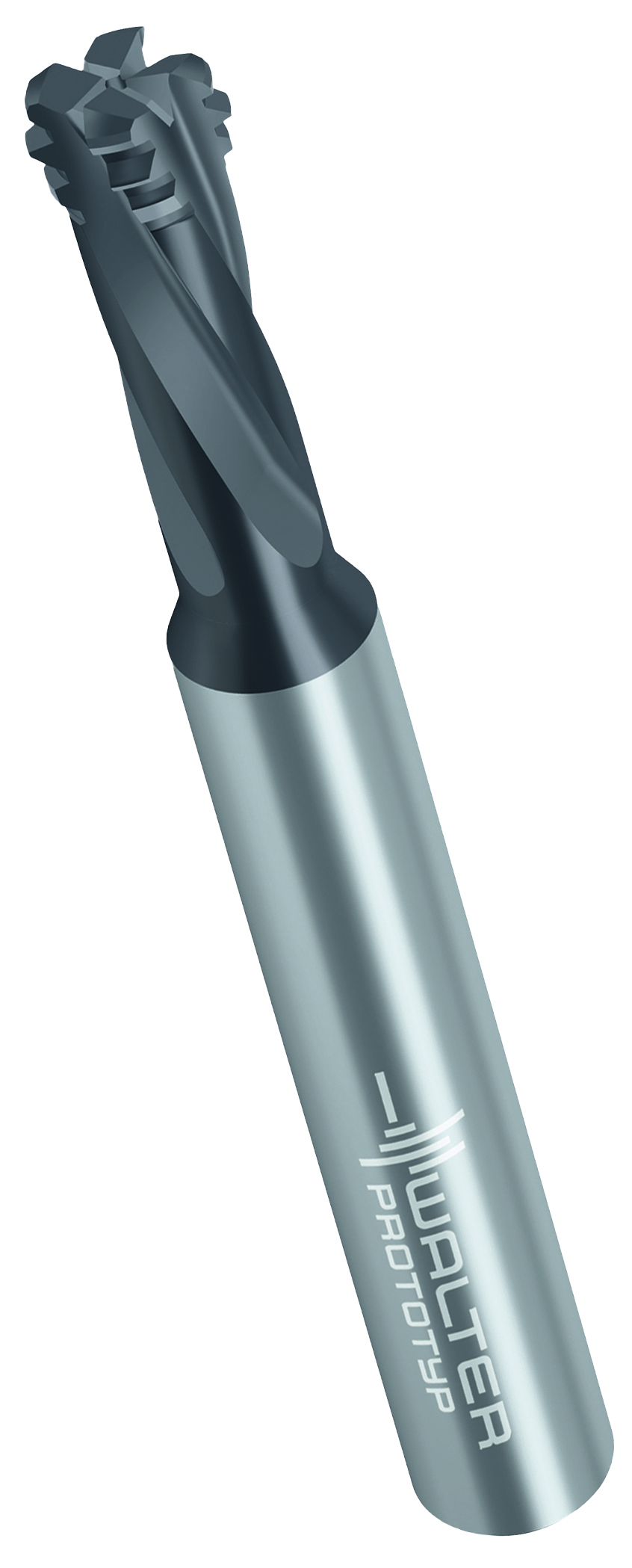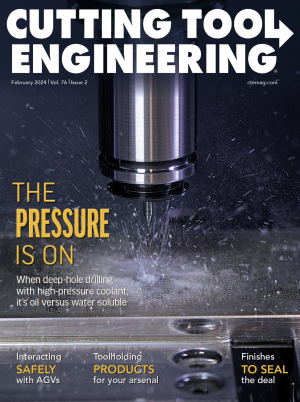The new Thrill∙tec™ TC645 Supreme thread milling cutter from Walter USA LLC, Greer, South Carolina, is said to boost productivity by combining the machining steps of chamfering, core-hole drilling and threading in a single tool and operation.
The TC645 Supreme orbital drilling and thread milling cutter is able to first produce a chamfer at the thread entry, then use helical interpolation to create the core hole and threads.

The left-hand cutting tool is ideal for small-series and mass production jobs alike, according to Walter. Mass production jobs benefit from long tool life and short cycle times. Shops using the tool on small production runs benefit from the reduction in tool changes and machine slots.
Made with Walter’s own WB10TJ grade coating, the TC645 Supreme is suitable for machining of steel, stainless steel, cast iron, nonferrous metal, super alloys and titanium alloys (ISO P, M, K, N and S material groups). A modified milling geometry on the tool face and an internal coolant duct for emulsion are said to maximize the tool’s life when machining workpiece materials as hard as 48 HRC.
All these features combined, along with a 20° helix, help to optimize chip removal, even when cutting at high speeds and feeds per tooth, according to technical data from Walter. The company added that the tool can be used for blind-hole and through-hole threads in dimensions of 2 or 2.5 x diameter deep.
Walter offers the TC645 in dimensions of M4 to M12, UNC 8 to UNC ½ and G1/16 to G¼, with plans for additional versions coming soon. The shank is in accordance with the DIN 6535 HA standard.
In addition to maximizing process reliability and its universality, the Thrill∙tec TC645 Supreme also offers a low cost per thread with its fast machining and indexing times, according to Walter.
Contact Details
Related Glossary Terms
- alloys
alloys
Substances having metallic properties and being composed of two or more chemical elements of which at least one is a metal.
- blind-hole
blind-hole
Hole or cavity cut in a solid shape that does not connect with other holes or exit through the workpiece.
- chamfering
chamfering
Machining a bevel on a workpiece or tool; improves a tool’s entrance into the cut.
- coolant
coolant
Fluid that reduces temperature buildup at the tool/workpiece interface during machining. Normally takes the form of a liquid such as soluble or chemical mixtures (semisynthetic, synthetic) but can be pressurized air or other gas. Because of water’s ability to absorb great quantities of heat, it is widely used as a coolant and vehicle for various cutting compounds, with the water-to-compound ratio varying with the machining task. See cutting fluid; semisynthetic cutting fluid; soluble-oil cutting fluid; synthetic cutting fluid.
- emulsion
emulsion
Suspension of one liquid in another, such as oil in water.
- gang cutting ( milling)
gang cutting ( milling)
Machining with several cutters mounted on a single arbor, generally for simultaneous cutting.
- interpolation
interpolation
Process of generating a sufficient number of positioning commands for the servomotors driving the machine tool so the path of the tool closely approximates the ideal path. See CNC, computer numerical control; NC, numerical control.
- milling
milling
Machining operation in which metal or other material is removed by applying power to a rotating cutter. In vertical milling, the cutting tool is mounted vertically on the spindle. In horizontal milling, the cutting tool is mounted horizontally, either directly on the spindle or on an arbor. Horizontal milling is further broken down into conventional milling, where the cutter rotates opposite the direction of feed, or “up” into the workpiece; and climb milling, where the cutter rotates in the direction of feed, or “down” into the workpiece. Milling operations include plane or surface milling, endmilling, facemilling, angle milling, form milling and profiling.
- milling cutter
milling cutter
Loosely, any milling tool. Horizontal cutters take the form of plain milling cutters, plain spiral-tooth cutters, helical cutters, side-milling cutters, staggered-tooth side-milling cutters, facemilling cutters, angular cutters, double-angle cutters, convex and concave form-milling cutters, straddle-sprocket cutters, spur-gear cutters, corner-rounding cutters and slitting saws. Vertical cutters use shank-mounted cutting tools, including endmills, T-slot cutters, Woodruff keyseat cutters and dovetail cutters; these may also be used on horizontal mills. See milling.
- shank
shank
Main body of a tool; the portion of a drill or similar end-held tool that fits into a collet, chuck or similar mounting device.
- threading
threading
Process of both external (e.g., thread milling) and internal (e.g., tapping, thread milling) cutting, turning and rolling of threads into particular material. Standardized specifications are available to determine the desired results of the threading process. Numerous thread-series designations are written for specific applications. Threading often is performed on a lathe. Specifications such as thread height are critical in determining the strength of the threads. The material used is taken into consideration in determining the expected results of any particular application for that threaded piece. In external threading, a calculated depth is required as well as a particular angle to the cut. To perform internal threading, the exact diameter to bore the hole is critical before threading. The threads are distinguished from one another by the amount of tolerance and/or allowance that is specified. See turning.
- through-hole
through-hole
Hole or cavity cut in a solid shape that connects with other holes or extends all the way through the workpiece.



